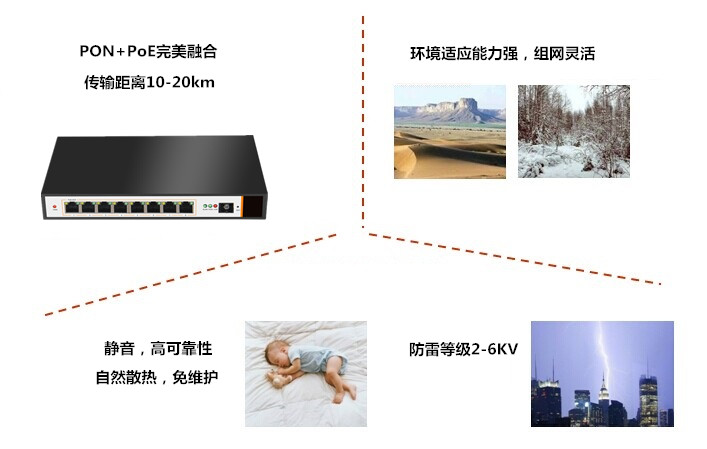
Challenge 1: Gradually toward high-definition
HD is becoming increasingly popular in the digital realm. Video surveillance users want to enjoy high-definition image quality. In areas such as transportation and safe cities, it is even more desirable to obtain more precise management of services with high-definition or ultra-high-definition images. At the same time, higher backhaul bandwidth requirements also impose high bandwidth requirements on video surveillance bearer networks.
Challenge 2: Gradually become networked
In order to obtain timely and convenient monitoring information, eliminate islands of information, integrate and share resources, and greatly increase the application value of existing massive video data. Video surveillance users hope that more and more video surveillance services will be real-time monitoring services, and monitoring data will also be changed from past local storage to centralized cloud storage. This requires the video surveillance service to be networked and able to return the monitoring screen and data in real time.
Challenge 3: A wide range of monitoring scenarios
Video surveillance has a wide range of application scenarios, and the installation and use environments are complex. In addition to public security monitoring, it has now expanded into homes, industries, and other fields, covering buildings, parks, public areas, and low-speed movements. Typical applications include urban security monitoring, community monitoring, campus inspections, reservoir maintenance, and management of densely populated public places. As the demand for safe cities continues to increase, video surveillance is attracting more and more attention. The demand is rising. This requires that the access plan can satisfy the use of various complex scenarios, including power supply mode, access mode, and installation mode.

With the development of modern cities towards multi-functions, the layout of cities has become increasingly complex, there are hundreds, hundreds, and even thousands of ground monitoring points. To ensure that functional departments can grasp real-time, clear, high-quality video images in the first place, The more prominent the tension of the active optical fiber resources. Moreover, in today's increasingly powerful and complex urban functions, re-laying optical cables is not only very costly, but also the coordination of all parties is more difficult. The use of PON passive optical access networks to build video transmission networks is the trend of the video surveillance industry.
What is PON?
PON is a passive optical network. It adopts point-to-multipoint structure and passive optical fiber transmission. It consists of OLT, ONU and POS. The distance between the OLT and the ONU can be up to 20km. The transmission rate is bidirectional symmetric 1Gbps. The maximum split ratio is generally 1:32 or higher. It can be divided into one level or multiple splitter stages.
In fact, as early as many years ago, telecom operators chose to use PON to solve the problem of fiber optic resource shortage. This not only gave full play to the bandwidth advantages of optical fiber, but also improved the reliability of the network. This technology can also be applied to security network monitoring.
In the monitoring, the central office OLT equipment is deployed in the central office and uses multi-stage optical splitting to achieve flexible deployment of points. The ONU+ webcam is used as the terminal combination; the bureau sends the upstream multicast data to the monitoring room and storage server of the customer at the same time. In the monitoring room, real-time monitoring can be performed, and the video data can be sent to the storage server at the same time to facilitate the collection of ex post evidence.

The advantages of PON in monitoring
PON technology has proved to be a very cost-effective way to monitor access, and it has always been regarded as the future direction of access network development. It can effectively solve network monitoring bandwidth bottlenecks and distance limitations. Because the entire network is passive, the number of devices in the network is small, and electromagnetic and lightning interferences are completely avoided. The reliability is better than that of active devices. With single-core optical fibers, half of the fiber cost can be saved, and the investment cost of the entire optical network is low. Improve the ultra-high bandwidth, meet the demand for high-definition monitoring; further increase the transmission distance, the distance from the OLT to the ONU can reach up to 20km.
The PON access solution can meet the needs of the evolution of the implementation plan from the initial construction to the large-scale construction of the monitoring, from the ONU through the Ethernet access IP camera to the camera integrated ONU.
Fengrun PON-PoE
Perhaps it is precisely to see the advantages of PON in video surveillance and the lack of PON applications in the security market. As the pioneer in the security industry, Fengrunda launched its OLT and ONU devices just fine, and took the lead in presenting a complete PON security solution. Accompanied by the availability of PON-based PoE switches, it created a precedent for ONUs with PoE on the domestic market.

EPS5081 is a typical representative of PON-PoE switches in the industry. It is an outstanding ONU access device and provides eight 100M adaptive PoE ports and one Gigabit PON port. The power supply to the IP terminal through the network cable effectively solves the problem that the network device is difficult to take power and difficult to construct. Cooperating with the mainstream OLT, it can provide EPON access services and is applicable to various application environments such as FTTB/FTTH.
The PON-PoE switch is a perfect combination of PON technology and PoE technology. It can be described as "strong and strong," and gives full play to each other's advantages in monitoring. It solves the problems of intensive and complicated monitoring points in modern cities, difficulties in power acquisition, and fiber optic resources. Network morphology, optical fiber resources, video quality, reliability, and other aspects have unparalleled advantages, not only providing better access solutions for the development of video surveillance services, but also greatly promoting the rapid development of high-definition network monitoring. Set off a revolution in network monitoring.
Holography is divided into two processes which are recording and reproduction,the interference fringes is generated on the holographic plate through the superposition between the reference light and the reflected light during the recording. Then, after the holographic plate is processed in the darkroom, an image exactly same to the original object will be reproduced from the interference pattern on the photosensitive sheet by diffraction. Compared with ordinary photographic, Holography not only records the amplitude of light field of the object, but also records the relative phase of the reflected light waves. Holography is widely used in holographic microscopy, holographic security, data storage, deformation measurement, holographic interferometry and etc.

Features
â– High reliability single longitudinal mode lasers ( coherence length >50m )
â– Easy to install and maintain. Relevant components can be provided
â– Customized solution can be provided upon request
Laser Related
Wavelengths: 360nm, 405nm, 457nm, 473nm, 532nm, 556 nm, 561 nm, 589 nm, 633 nm, 656nm, 660nm, 671nm, 1064nm,
1342nm, 1550nm, etc. Multi-wavelengths system is also available on request.

Accessories

Research achievements of CNI Laser for Optogenetics from customers
(1) Three-dimensional holographic photostimulation of the dendritic arbor
(J. Neural Eng. 8 046002; doi:10.1088/1741-2560/8/4/046002) (CNI-405nm)
(2) Two-wavelength exposure enhancement in holographic data storage of spirooxazine-doped polymers
(Optics Communications Vol. 338, 1 March 2015, Pages 269–276) (CNI-405nm)
(3) Depth resolved hyperspectral imaging spectrometer based on structured light illumination and Fourier
transform interferometry (Biomedical Optics Express, Vol. 5, Issue 10, pp. 3494-3507 (2014)) ( CNI-473nm)
(4) Optical magnetic imaging of living cells (Nature 496, 486–489 (25 April 2013)doi:10.1038/nature12072) (CNI- 532nm)
(5) Multi-wavelength laser sensor for intruder detection and discrimination
(Optics and Lasers in Engineering Vol. 50, Issue 2, Pages 176–181) (CNI-532nm)
(6) Optical observation of shock waves and cavitation bubbles in high intensity laser-induced shock processes
(Applied Optics, Vol. 48, Issue 19, pp. 3671-3680 (2009)) (CNI-532nnm)
(7) Microscope spectrometer for light scattering investigations (Applied Optics, Vol. 49, Issue 22, pp. 4193-4201 (2010)) ( CNI-671nm/532nm)
Lasers for Holography,Hologram Lasers,Laser Hologram,Laser Hologram Projector
Changchun New Industries Optoelectronics Technology Co., Ltd. , https://www.lasersciences.com